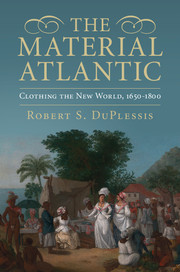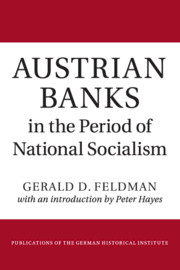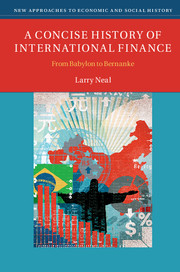Refine search
Actions for selected content:
26946 results in Economic history
Put-call parity, the triple contract, and approaches to usury in medieval contracting
-
- Journal:
- Financial History Review / Volume 22 / Issue 2 / August 2015
- Published online by Cambridge University Press:
- 09 October 2015, pp. 205-233
-
- Article
- Export citation
FHR volume 22 issue 2 Cover and Front matter
-
- Journal:
- Financial History Review / Volume 22 / Issue 2 / August 2015
- Published online by Cambridge University Press:
- 09 October 2015, pp. f1-f3
-
- Article
-
- You have access
- Export citation

The Material Atlantic
- Clothing, Commerce, and Colonization in the Atlantic World, 1650–1800
-
- Published online:
- 05 October 2015
- Print publication:
- 14 October 2015

Austrian Banks in the Period of National Socialism
-
- Published online:
- 05 October 2015
- Print publication:
- 15 September 2015

A Concise History of International Finance
- From Babylon to Bernanke
-
- Published online:
- 05 October 2015
- Print publication:
- 22 October 2015
Editor's Introduction
-
- Journal:
- Business History Review / Volume 89 / Issue 3 / Autumn 2015
- Published online by Cambridge University Press:
- 28 September 2015, pp. 403-404
- Print publication:
- Autumn 2015
-
- Article
-
- You have access
- HTML
- Export citation
Trade and Institutions in the Medieval Mediterranean: The Geniza Merchants and Their Business World. ByJessica L. Goldberg. Cambridge, U.K.: Cambridge University Press, 2012. xxi + 426 pp. Figures, maps, tables, glossary, bibliography, notes. Cloth, $120.00. ISBN: 978-1-107-00547-1.
-
- Journal:
- Business History Review / Volume 89 / Issue 3 / Autumn 2015
- Published online by Cambridge University Press:
- 28 September 2015, pp. 583-586
- Print publication:
- Autumn 2015
-
- Article
- Export citation
Toxic Aid: Economic Collapse and Recovery in Tanzania. BySebastian Edwards. Oxford: Oxford University Press, 2014. xxiv + 290 pp. Figures, tables, bibliography, index. Cloth, $56.00. ISBN: 978-0-19-870442-3.
-
- Journal:
- Business History Review / Volume 89 / Issue 3 / Autumn 2015
- Published online by Cambridge University Press:
- 28 September 2015, pp. 623-626
- Print publication:
- Autumn 2015
-
- Article
- Export citation
Paths toward the Modern Fiscal State: England, Japan, and China. ByWenkai He. Cambridge, Mass.: Harvard University Press, 2013. x + 313 pp. Figures, bibliography, notes, index. Cloth, $55.00. ISBN: 978-0-674-07278-7.
-
- Journal:
- Business History Review / Volume 89 / Issue 3 / Autumn 2015
- Published online by Cambridge University Press:
- 28 September 2015, pp. 615-617
- Print publication:
- Autumn 2015
-
- Article
- Export citation
The Politics of Industrial Collaboration during World War II: Ford France, Vichy and Nazi Germany. ByTalbot Imlay and Martin Horn. Cambridge, U.K.: Cambridge University Press, 2014. x + 291 pp. Appendix, bibliography, notes, index. Cloth, $99.00. ISBN: 978-1-107-01636-1.
-
- Journal:
- Business History Review / Volume 89 / Issue 3 / Autumn 2015
- Published online by Cambridge University Press:
- 28 September 2015, pp. 612-615
- Print publication:
- Autumn 2015
-
- Article
- Export citation
Dr. John Harvey Kellogg and the Religion of Biologic Living. ByBrian C. Wilson. Bloomington: Indiana University Press, 2014. xix + 240 pp. Illustrations, photographs, bibliography, notes, index. Cloth, $35.00. ISBN: 978-0-253-01447-4.
-
- Journal:
- Business History Review / Volume 89 / Issue 3 / Autumn 2015
- Published online by Cambridge University Press:
- 28 September 2015, pp. 609-612
- Print publication:
- Autumn 2015
-
- Article
- Export citation
Forging Capitalism: Rogues, Swindlers, Frauds, and the Rise of Modern Finance. ByIan Klaus. New Haven: Yale University Press, 2014. viii + 287 pp. Illustrations, notes, index. Cloth, $30.00. ISBN: 978-0-300-18833-2.
-
- Journal:
- Business History Review / Volume 89 / Issue 3 / Autumn 2015
- Published online by Cambridge University Press:
- 28 September 2015, pp. 580-583
- Print publication:
- Autumn 2015
-
- Article
- Export citation
The History of Multinationals: A 2015 View
-
- Journal:
- Business History Review / Volume 89 / Issue 3 / Autumn 2015
- Published online by Cambridge University Press:
- 28 September 2015, pp. 405-414
- Print publication:
- Autumn 2015
-
- Article
-
- You have access
- HTML
- Export citation
Building Co-operation: A Business History of the Co-operative Group, 1863–2013. ByJohn F. Wilson, Anthony Webster, and Rachael Vorberg-Rugh. Oxford: Oxford University Press, 2013. xv + 440 pp. Figures, tables, illustrations, photographs, appendix, bibliography, notes, index. Cloth, $45.00. ISBN: 978-0-19-965511-3.
-
- Journal:
- Business History Review / Volume 89 / Issue 3 / Autumn 2015
- Published online by Cambridge University Press:
- 28 September 2015, pp. 598-600
- Print publication:
- Autumn 2015
-
- Article
- Export citation
Hall of Mirrors: The Great Depression, the Great Recession, and the Uses—and Misuses—of History
-
- Journal:
- Business History Review / Volume 89 / Issue 3 / Autumn 2015
- Published online by Cambridge University Press:
- 28 September 2015, pp. 557-569
- Print publication:
- Autumn 2015
-
- Article
-
- You have access
- HTML
- Export citation
Lending to the Borrower from Hell: Debt, Taxes, and Default in the Age of Philip II. ByMauricio Drelichman and Hans-Joachim Voth. Princeton: Princeton University Press, 2014. xiii + 310 pp. Figures, tables, references, index. Cloth, $35.00. ISBN: 978-0-691-15149-6.
-
- Journal:
- Business History Review / Volume 89 / Issue 3 / Autumn 2015
- Published online by Cambridge University Press:
- 28 September 2015, pp. 586-588
- Print publication:
- Autumn 2015
-
- Article
- Export citation
Multinationals and Gender: Singer Sewing Machine and Marketing in Mexico, 1890–1930
-
- Journal:
- Business History Review / Volume 89 / Issue 3 / Autumn 2015
- Published online by Cambridge University Press:
- 28 September 2015, pp. 531-549
- Print publication:
- Autumn 2015
-
- Article
-
- You have access
- HTML
- Export citation
Announcements
-
- Journal:
- Business History Review / Volume 89 / Issue 3 / Autumn 2015
- Published online by Cambridge University Press:
- 28 September 2015, pp. 551-555
- Print publication:
- Autumn 2015
-
- Article
-
- You have access
- HTML
- Export citation
BHR volume 89 issue 3 Cover and Front matter
-
- Journal:
- Business History Review / Volume 89 / Issue 3 / Autumn 2015
- Published online by Cambridge University Press:
- 28 September 2015, pp. f1-f7
- Print publication:
- Autumn 2015
-
- Article
-
- You have access
- Export citation
Defending the History of Economic Thought. BySteven Kates. Cheltenham, U.K.: Edward Elgar Publishing, 2013. x + 140 pp. Bibliography, index. Cloth, $99.00. ISBN: 978-1-84844-820-9.
-
- Journal:
- Business History Review / Volume 89 / Issue 3 / Autumn 2015
- Published online by Cambridge University Press:
- 28 September 2015, pp. 573-575
- Print publication:
- Autumn 2015
-
- Article
- Export citation
